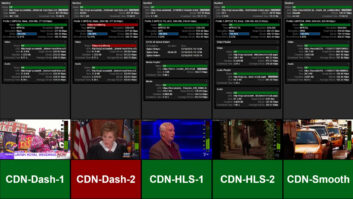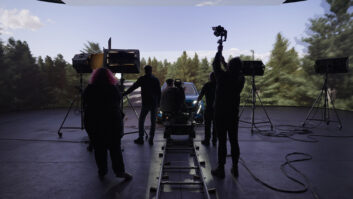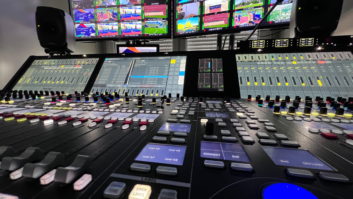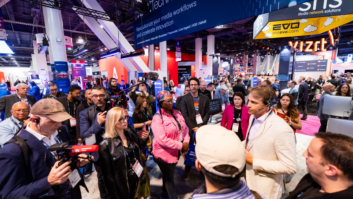LG Electronics and Harris, joint developers of the mobile-pedestrian handheld (MPH) in-band mobile digital television system, have submitted a proposal to the ATSC for a standard that would enable broadcasters to provide high-quality digital television signals to a wide range of mobile and portable devices, writes Andy Stout.
The broadcast and consumer electronics industries have identified mobile and handheld DTV as important new opportunities for the future of local broadcasting, providing new revenue streams for device manufacturers and broadcasters, and new services to customers. These new mobile and handheld services, using ATSC-compatible broadcast transmissions, can help spur the adoption of handheld devices by consumers who want value-added services that are currently not available through regular broadcast TV delivery models. With MPH, consumers can view their favourite programmes from local broadcasters, watch movies and sports, check local news and weather information and access pay services even when travelling in fast-moving vehicles or using handheld video devices away from home.
Developed by Harris Corporation and LG Electronics and its US research subsidiary, Zenith, the MPH in-band mobile DTV system provides robust DTV signals to mobile, pedestrian and handheld devices. Harris and LG designed MPH to be fully compatible with the ATSC A/110 standard for distributed transmission. As such, the system provides a highly compatible, commercially deployable system that has already been accomplished, tested and demonstrated.
Until now, reliable reception of signals transmitted by terrestrial broadcasters has not been possible in fast-moving vehicles or pedestrian handheld devices such as mobile phones or laptop computers. Unlike the cellular-based approach, MPH technology uses only the single, existing transmitter from commercial and public broadcasters. For broadcasters, this new technology enables new and potentially lucrative revenue streams.
MPH is a multiple-stream system, with the main service stream for existing DTV and HDTV services, and the MPH stream for one or more mobile, pedestrian and/or handheld services. Another advantage of the MPH system is that it does not require outside service providers or spectrum-pooling arrangements.
In their response to the ATSC RFP, Harris and LG Electronics provided a technical overview of the MPH system, which enhances a portion of the ATSC broadcast symbol stream for increased capability in the areas of Doppler and multipath. “The enhancement is achieved by a combination of improved forward error correction (FEC) and added training signals,” said the document. “The MPH system uses time multiplexing of legacy ‘main’ or ‘normal’ transport packets with enhanced packets, such that the only modification to the main packets is their timing. In addition, the enhanced packets and added training signals are coded so as to be compatible with legacy FEC, assuring 100% backward compatibility with legacy receivers. Legacy receivers regard the MPH packets as NULL packets whose content is ignored.”
Other excerpts from the RFP response: “The special physical layer processing of MPH data has been designed so it can all take place at the transmission exciter, without special processing at the service multiplexer. The service multiplexer needs only to be set up to provide all the main and enhanced data as part of a normal ATSC packet stream, with sufficient NULL packets to allow for addition of FEC symbols in the exciter. The existing single legacy studio-transmitter link is all that is required,” the companies explained to the ATSC.
“MPH is highly flexible in its use of data capacity, and can be controlled statically or dynamically to take from less than 200kbps (eg for a single audio or data service), up to multiple megabits per second (when only a single SD programme is required in the main channel). The MPH stream itself can consist of a single or multiple services, and the use of MPH places no restrictions on use of the main stream for a single HD or multiple HD and/or SD programmes. There is no hard limit to the number of MPH services allowed; there is only a total data rate limitation. MPH has also been designed for full compatibility with the ATSC A/110 standard for Distributed Transmission (single-frequency networks),” according to the RFP response.
“As long-time, active members of the ATSC and key players in the development and marketplace implementation of digital television, LG Electronics, its US R&D lab and Harris look forward to working closely with our fellow ATSC members and with ATSC staff on mobile DTV,” said Dr. H.G. Lee, president and CTO of LG Electronics. “We share the ATSC’s enthusiasm for this promising new technology, which we believe will enhance and complete the digital television experience for consumers and broadcasters alike.”
“In light of the sense of urgency surrounding this next generation of DTV technology, Harris and LG look forward to participating in the ATSC mobile DTV process while continuing to work with broadcasters and other stakeholders to develop a robust, mobile terrestrial DTV market,” said Tim Thorsteinson, president of the Harris Broadcast Communications Division. “The MPH system strikes the right balance for broadcasters looking to deliver both high definition programming to fixed receivers and programming and datacasting to mobile and handheld devices.”







